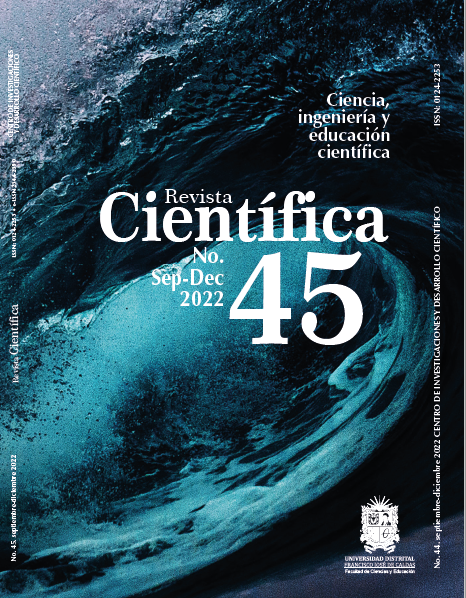DOI:
https://doi.org/10.14483/23448350.19584Published:
09/07/2022Issue:
Vol. 45 No. 3 (2022): September-December 2022Section:
Ciencia y TecnologíaMapas de información colaborativa para la delimitación de predios, bicirrutas y sitios turísticos en Tunja, Boyacá
Collaborative Information Maps for the Delimitation of Properties, Bicycle Routes, and Tourist Sites in Tunja, Boyacá
Keywords:
biciusuarios, crowdmapping, delimitación de tierras, geolocalización de datos, representación información geográfica, mapeo turístico, participación colectiva (es).Keywords:
bicycle users, collective participation, crowdmapping, data geolocation, land delimitation, touristic mapping (en).Downloads
Abstract (es)
Las nuevas tecnologías y los avances tecnológicos han contribuido a una mayor interacción con plataformas como el crowdmapping, que permiten a las personas u organizaciones tener un flujo informativo con el cual pueden realizar aportes a través de mapas colaborativos. Con el fin de conocer sus aplicaciones y usos, se realizó una revisión sistemática de la aplicación e importancia del crowdmapping y su contribución en la creación de mapas en diferentes sectores o áreas en la sociedad. A partir de esta revisión se determinó la utilidad y eficiencia de este tipo de mapeo en la delimitación de predios y bicirrutas, así como en la geolocalización de los sitios turísticos en Tunja (Boyacá, Colombia), con el fin de que cualquier persona que accediera a los mapas pudiera participar, apropiarse de la información y aportar según su interés. Dicha implementación muestra un aporte para que las personas conozcan y puedan guiar y brindar información relevante tanto a ciudadanos como a turistas sobre las diferentes rutas para biciusuarios o lugares turísticos de la cuidad. En estos casos, dicha información es proporcionada por personas que han vivido la experiencia y desean compartirla, creando así mapas colaborativos en tiempo real. Ante dichos mapas, es importante validar toda la información en aras de que esta sea completamente real y este tipo de plataformas genere confianza para su posterior implementación en otros proyectos con objetivo social.
Abstract (en)
New technologies and technological advances have contributed to a greater interaction with platforms such as crowdmapping, which allow people or organizations to have an information flow with which they can make contributions through collaborative maps. In order to understand its applications and uses, a systematic review was conducted on the application and importance of crowdmapping and its contribution to the creation of maps in different sectors or areas of society. From this review, the usefulness and efficiency of this type of mapping was determined regarding the delimitation of properties and bike routes, as well as the geolocation of tourist sites in Tunja (Boyacá), so that anyone accessing the maps could participate, appropriate the information, and contribute according to their interests. Said implementation makes its contribution people to know and be able to guide and provide relevant information to both citizens and tourists on the different routes for bicycle users or tourist sites in the city. In these cases, such information is provided by people who have lived the experience and want to share it, thus creating collaborative maps in real time. As for these maps, it is important to validate all the information in order for it to be completely real and for this type of platform to generate confidence for later implementation in other projects with a social aim.
References
Da Silva, P. (2015). CICLOVIX - Sistema Colaborativo de Mapas Cicloviários [Trabajo de grado]. Universidade Vila Velha, Brasil. https://doi.org/10.13140/RG.2.1.2859.7367
Espinoza-Ramírez, A., Nakano, M., Sánchez-Pérez, G., Arista-Jalife, A. (2018). Sistemas de información geográfica y su análisis aplicado en zonas de delincuencia en la Ciudad de México. Información Tecnológica, 29(5), 235-244. https://doi.org/10.4067/S0718-07642018000500235 DOI: https://doi.org/10.4067/S0718-07642018000500235
Gallardo Escalona, L. (2013). Open social learning Crowdmap . Building alternative ways… [Trabajo de fin de máster]. Universidad Nacional de Educación a Distancia, España. https://redined.educacion.gob.es/xmlui/handle/11162/184205
Llorente del Río, A. (2012). Cartografía delictiva: herramientas SIG y mapas on-line. Revista Catalana de Geografía, 17(46), 1-11
Martínez, R., Rodríguez, R., Vera, P. (s.f.). Estrategia para la implementación de aplicaciones móviles basadas en servicios de geolocalización y crowdsourcing. http://imgbiblio.vaneduc.edu.ar/fulltext/files/TC121034.pdf
Martínez, R., Rodríguez, R., Vera, P. (2016). Metodología para el tratamiento del proceso de crowdsourcing en aplicaciones móviles basadas en servicios de geolocalización. Revista Latinoamericana de Ingeniería de Software, 4(4), 175-186. https://doi.org/10.18294/relais.2016.175-186 DOI: https://doi.org/10.18294/relais.2016.175-186
Medina Roa, J., Lesmes Ortiz, L. V., Callejas Rodríguez, N. (2018). El turismo como una oportunidad de crecimiento económico para Boyacá: turismo cultural en Tunja. L. V. Lesmes Ortiz (Comp.), Investigación con impacto regional nuevas tendencias administrativas (pp. 15-68). Ediciones Usta - Universidad Santo Tomás. https://doi.org/10.15332/dt.inv.2020.02699 DOI: https://doi.org/10.15332/dt.inv.2020.02699
Merino Egea, M. (2014). Diseño para el desarrollo. Diseño y Tecnología para el Desarrollo, 1, 48-78
Morales Campos, E. M. (2004). Internet y sociedad: relación y compromiso de beneficios. Revista Digital Universitaria, 5(8), 1-10
Pinilla Guerrero, K. V. (2017). Iniciativa de mapeo libre de experiencias de agricultura urbana en Bogotá y sus alrededores, “Agroecobogota” (2014-2016). Revista de Geografía (Recife), 34(2), 4-25. https://doi.org/10.51359/2238-6211.2017.229347 DOI: https://doi.org/10.51359/2238-6211.2017.229347
Quirós, E., Polo, M. E. (2018). Recursos abiertos de información geográfica para investigación y documentación científica. Revista Española de Documentación Científica, 41(3), e1512. https://doi.org/10.3989/redc.2018.3.1512 DOI: https://doi.org/10.3989/redc.2018.3.1512
Rodríguez, A. S. (2021). Expansión territorial y periurbanización en Tunja - Boyacá [Trabajo de Grado]. Universidad Piloto de Colombia, Colombia. http://repository.unipiloto.edu.co/handle/20.500.12277/10736
Sandoval-Martín, T., Espiritusanto, Ó. (2016). Geolocalización de información y mapeo de datos en periodismo online con Ushahidi. Profesional de la Información, 25(3), 458-472. https://doi.org/10.3145/epi.2016.may.16 DOI: https://doi.org/10.3145/epi.2016.may.16
How to Cite
APA
ACM
ACS
ABNT
Chicago
Harvard
IEEE
MLA
Turabian
Vancouver
Download Citation
License
Copyright (c) 2022 Wilmer-Andrés Romero-Hernández, Juan-Sebastián González-Sanabria, Fabián-David Güiza-Pinzón

This work is licensed under a Creative Commons Attribution-NonCommercial-ShareAlike 4.0 International License.
When submitting their article to the Scientific Journal, the author(s) certifies that their manuscript has not been, nor will it be, presented or published in any other scientific journal.
Within the editorial policies established for the Scientific Journal, costs are not established at any stage of the editorial process, the submission of articles, the editing, publication and subsequent downloading of the contents is free of charge, since the journal is a non-profit academic publication. profit.




